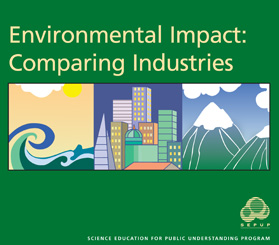Environmental Impact: Comparing Industries – Module Issues in the News for Students

News
Environmental Impact: Comparing Industries
Scroll down to read summaries of recent news related to the environmental impact of making products.
Recycling Ash to Make Consumer Products
People recycle paper, aluminum cans, and plastic. But recycling ash? It may happen. Much of the energy in the United States comes from burning coal. The byproducts of the coal combustion are mostly ash and may amount to one hundred million tons each year. Researchers with the Energy and Environmental Research Center (EERC) believe these byproducts are a valuable resource and should be reused. At the present time, only 30% is being reused.
Coal ash can be used in products ranging from bowling balls to building materials. Some of the building products currently produced from coal ash include ceiling tiles, floor tiles, and dry wall. Using coal ash products conserves land, energy and natural resources. It also reduces air pollution because there is less carbon dioxide going into the atmosphere during the production of competing products.
“Coal ash is not a waste, but rather a partially refined resource,” said EERC Director Gerald Groenewold. “Through quality research and development efforts, we are finding innovative ways of taking these materials and turning them into a quality, useable products.”
A Three-And-A-Half Pound Computer Chip?
It sounds ridiculous that a computer microchip could be 3.5 pounds! But that’s the weight of the estimated energy needed to produce one computer chip. Scientists say that a microchip that weighs 2 grams requires at least 3.7 pounds of fossil fuels and chemicals to produce.
Researchers looked at the life cycle of a microchip from the raw materials to the finished product. They considered such things as the amount of carbon dioxide released from fossil fuels during chip production. They also looked at the impact of the chemicals used during production on air, water and soil. They found that each chip required 3.5 pounds of fossil fuels, 0.16 pounds of chemicals, 70.5 pounds of water and 1.5 pounds of elemental gases (mainly nitrogen).
Many experts believe that, as technology increases, the amount of materials and energy needed to produce new products will decrease. This is known as dematerialization. The microchip is often used as a prime example of dematerialization because of its high efficiency and small size. This study, headed by Dr. Eric Williams of the United Nations University in Tokyo, Japan, seems to suggest otherwise.

